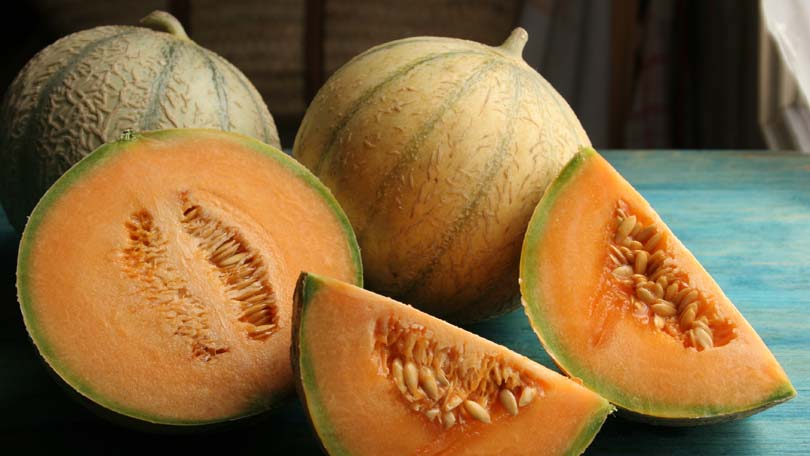Melons are classified as a fruit, and although certainly sweeter than their squash and cucumber cousins, they do join those vine-growing vegetables as members of the same gourd family. Melons are used in a variety of recipes, but are perhaps enjoyed most often around the world in their natural, fresh state.
Watermelon is the most common variety of melon, with approximately 50 sub-types available. It originated in Africa and there is evidence that dates its cultivation back to the Bronze Age. China is the leading watermelon producer today, although several regions in the United States also produce watermelons commercially. With the highest water content of any fruit, the watermelon’s juicy red flesh has become synonymous with summer fun and refreshment.
Cantaloupes are the most nutritious of all melon varieties with its high content of vitamin C, beta-carotene, and potassium. They have a netted cream and green skin with a sweet orange flesh. Other melons with netted skin include the Persian (rounder and larger than the cantaloupe with firmer flesh) and the Santa Claus or Christmas (with dark green and yellow striped skin, and a flavor similar to Casaba but not as sweet). Cantaloupes are in their peak season in the summer.
Honeydew is a smoother-skinned melon. It has light yellow skin and pale green flesh; it has the sweetest flavor of any melon. Other melons with smooth skin include the Crenshaw (a cross between Casaba and Persian with a lightly spicy flesh) and the Casaba (round with yellow skin and green, sweet flesh).
While watermelons most closely resemble their cucumber cousins with their seeds scattered throughout their fruit, other melons tend to resemble squash with their seeds gathered in a cavity at the center of the fruit.
Although melons come in a broad range of varieties and sub-types, they require similar shopping guidelines. When selecting melon, look for one that is heavy for its size, as a hefty weight normally indicates plenty of flavorful juice. Also check for a strong fragrance, as fragrance almost always equals flavor. The melon should be firm but slightly springy when you apply gentle pressure with your fingers; the skin should be whole and free of bruises, cracks, or shriveling. Avoid any melon that even hints at mushiness.
If your melon is not ripe enough when you purchase it, you can ripen it at home. To accelerate the ripening process, put the melon in a paper bag with an apple, banana, pear, or tomato; these fruits emit ethylene, a gas that hastens ripening. This process might take up to four days, but check your fruit frequently to prevent over-ripening.
Uncut melons will keep up to two weeks at room temperature, although you should wrap and refrigerate them once you have cut them. Cut melon will keep up to three days in the refrigerator, but they taste best if allowed to reach room temperature before serving.
Most melons are perfectly delicious served fresh. You can slice them, cube them, serve them as a half with seeds scooped out, or shaped into balls with a special melon ball tool. A scooped out melon shell makes a lovely bowl for fruit salad; a particularly crafty cook can carve a handle from the top half of the melon while preserving the bottom of the melon as the bowl.
Here is a recipe for a simple yet elegant appetizer. You might try experimenting by adding other fruits, or drizzling with a balsamic vinegar reduction.
Prosciutto-Wrapped Melon
1 melon, cut into 6 wedges
18 paper-thin prosciutto slices
Wrap one melon wedge in three slices of prosciutto.
Repeat with the remaining melon wedges and prosciutto slices.
If desired, garnish with a sprig of fresh parsley or other garden green.
Breakfast shakes are usually the domain of berries or citrus. Here is something new to try, and the result is refreshingly delicious and nutritious.
Top of Form
Summer Melon Smoothie
¼ cantaloupe
¼ honeydew
juice of 1 lime
Optional garnish: lime wedges or mint sprigs
Peel and seed melons.
Cut into 1-inch cubes.
If time allows, freeze melon cubes. Otherwise, use them as is. (Freezing the melon will make your smoothie thicker.)
Combine melon and lime juice in blender container.
Blend until smooth.
Pour into a tall glass. If you like, garnish with a lime wedge or mint sprig before serving.






